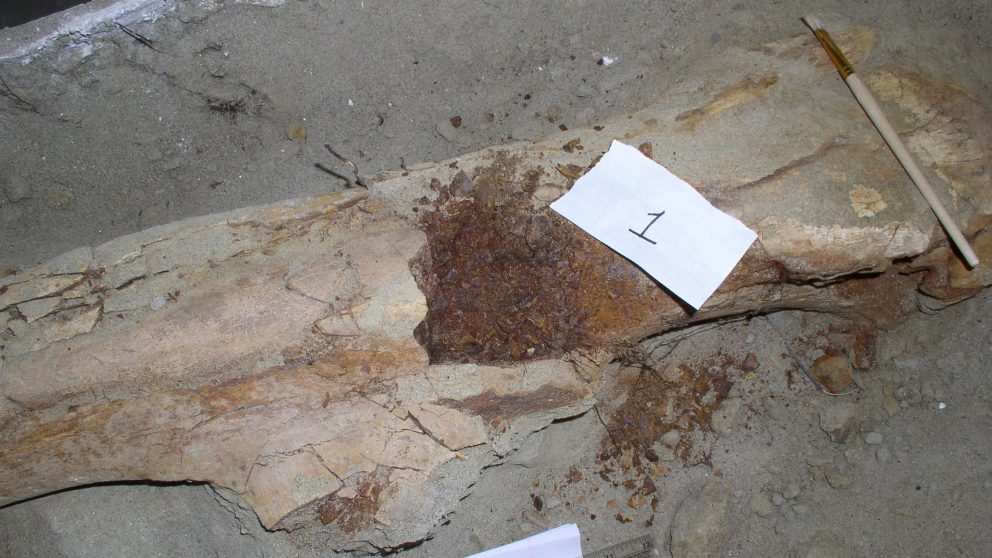Expansion for the Brachylophosaurus canadensis Collagen I Sequence and Additional Evidence of the Preservation of Cretaceous Protein
Elena R. Schroeter*† , Caroline J. DeHart‡, Timothy P. Cleland§, Wenxia Zheng†, Paul M. Thomas‡ , Neil L. Kelleher‡ , Marshall Bern∥, and Mary H. Schweitzer†⊥
† Department of Biological Sciences, North Carolina State University, Raleigh, North Carolina 27695, United States
‡ National Resource for Translational and Developmental Proteomics, Northwestern University, Evanston, Illinois 60208, United States
§ Department of Chemistry, University of Texas-Austin, Austin, Texas 78712, United States
∥ Protein Metrics, San Carlos, California 94070, United States
⊥ North Carolina Museum of Natural Sciences, Raleigh, North Carolina 27601, United States
J. Proteome Res., Article ASAP
Publication Date (Web): January 23, 2017
Copyright © 2017 American Chemical Society
*E-mail: easchroe@ncsu.edu.

Brachylophosaur canadensis fossil femur (MOR 2598) in field jacket, showing area of sampling for molecular analyses.
Source - Fonte: NC State University
Abstract
Sequence data from biomolecules such as DNA and proteins, which provide critical information for evolutionary studies, have been assumed to be forever outside the reach of dinosaur paleontology. Proteins, which are predicted to have greater longevity than DNA, have been recovered from two nonavian dinosaurs, but these results remain controversial. For proteomic data derived from extinct Mesozoic organisms to reach their greatest potential for investigating questions of phylogeny and paleobiology, it must be shown that peptide sequences can be reliably and reproducibly obtained from fossils and that fragmentary sequences for ancient proteins can be increasingly expanded. To test the hypothesis that peptides can be repeatedly detected and validated from fossil tissues many millions of years old, we applied updated extraction methodology, high-resolution mass spectrometry, and bioinformatics analyses on a Brachylophosaurus canadensis specimen (MOR 2598) from which collagen I peptides were recovered in 2009. We recovered eight peptide sequences of collagen I: two identical to peptides recovered in 2009 and six new peptides. Phylogenetic analyses place the recovered sequences within basal archosauria. When only the new sequences are considered, B. canadensis is grouped more closely to crocodylians, but when all sequences (current and those reported in 2009) are analyzed, B. canadensis is placed more closely to basal birds. The data robustly support the hypothesis of an endogenous origin for these peptides, confirm the idea that peptides can survive in specimens tens of millions of years old, and bolster the validity of the 2009 study. Furthermore, the new data expand the coverage of B. canadensis collagen I (a 33.6% increase in collagen I alpha 1 and 116.7% in alpha 2). Finally, this study demonstrates the importance of reexamining previously studied specimens with updated methods and instrumentation, as we obtained roughly the same amount of sequence data as the previous study with substantially less sample material. Data are available via ProteomeXchange with identifier PXD005087.
Keywords: Archosauria; bone; Brachylophosaurus canadensis; collagen I; paleoproteomics; phylogenetics
Subscription or payment needed - Requer assinatura ou pagamento:


